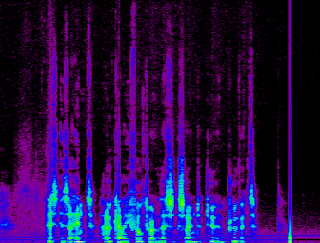Let's first look at the unedited waveform:
Removing the tone
In this case of course, there is. A continuous tone with the faint hints of what might be speech buried in there. I have no idea what the frequency of the tone is, but my first point of approach was to see how it looks in the spectrum filter.
There is a clear spike between 400Hz and 500Hz. Like with the previous exercise, we create anchors on the spectrum filter and reduce where I believe the pure tone is.
After some tweaking with the positions of the anchors I can no longer hear the pure tone on the preview. After applying the filter the waveform now appears as follows:
Looks much better, at least from this distance. Playback sounds a little low quality however, not to mention quiet. So let's raise the volume.
Removing Noise
The spectrogram of the result of this operation shows that there's a fair degree of noise in the sound. In an attempt to reduce the amount of noise I used the equaliser filter in order to allow the more common frequencies in human speech (between 300 and 3000Hz) to come through.
Certainly it's reduced some of the noise, as can be seen by comparing the spectrograms with each other. Although it did also make the speech sound a little tinny, so I went with slightly different settings to achieve what I think is a higher quality sound.
Reverb - Making it sound like it's in a church hall
Making the speech sound like it was recorded in a church hall is relatively easy in GoldWave. All you do is apply a reverb through Effects -> Reverb in the top menu.
I elected to use the above settings, starting with the Concert Hall preset and reducing the reverb time slightly as a Concert Hall tends to be larger.







No comments:
Post a Comment